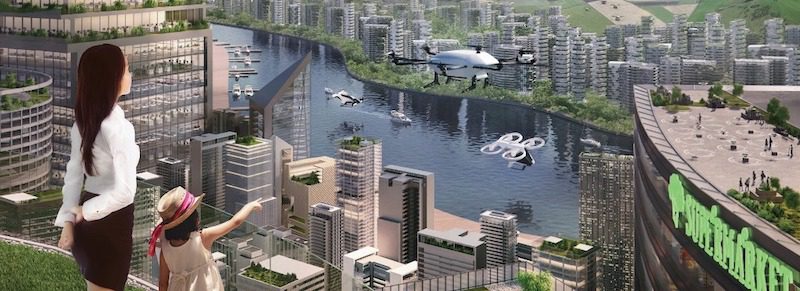
The European Network of U-Space Stakeholders held a virtual event this week where European officials discussed the technological and public acceptance challenges associated with integrating drones and eVTOLs into European airspace, such as what is envisioned by this conceptual rendering from Airbus. (Airbus)
At the virtual relaunch of the European Network of U-Space Stakeholders this week, Jacek Woznikowski, Director of the Department of Socio-Economic Development and Cooperation in Metropolis GZM, Poland, spoke on the topics of Urban Air Mobility (UAM) and Sustainable Urban Mobility Planning. He asked attendees to consider: What kind of city would we like to live in? What can urban mobility add to the ecosystem?
In 2017, the European Commission established UIC2, a community of 46 cities/regions in Europe, as part of the EU’s Smart Cities Marketplace. Woznikowski represents Metropolis GZM, one of the member regions of UIC2, to explain their approach to introducing drones in an urban area. In order to drive a sustainable and responsible transition, UIC2 focuses on task forces in three key areas: first, establishment of public and private support; second, collaboration with citizens; and third, pursuit of synergy between ground and air transportation.
Urban air mobility is defined by UIC2 as “very low altitude airborne traffic, above populated areas, at scale, that is sustainably integrated with surface mobility systems.” Woznikowski emphasizes the importance of this sustainable integration, saying that the focus should be city-centric and driven by citizens’ needs. The ideal approach, he explains, is one that utilizes multiple stakeholders and multi-level governance. Additionally, aviation experts should work together with mobility/planning experts towards a common goal rather than working separately towards unrelated goals. According to Woznikowski, partners of UIC2 believe that “technology needs to serve cities, not the other way around.”
The European Union Aviation Safety Agency (EASA) released a report in May concerning EU citizens’ perspectives on UAM vehicles. Most of the survey’s 4,000 respondents had a positive view of UAM: “It is seen as a new and attractive means of mobility, and a majority is ready to try it out.” Concerns included potential safety risks, noise, security, and environmental impact. One emerging viewpoint was that UAM vehicles and infrastructure may “improve the local environmental footprint through reduced urban traffic congestion and better local air quality,” although many citizens held concerns about the impact on wildlife. Respondents anticipated more security problems when asked about drones. “The use of drones for delivery purposes garnered less support. ‘The security concern is around 10 percent higher for drones,’” commented EASA Executive Director Patrick Ky.
Henrik Hololei, Director General for Mobility and Transport at the European Commission, was the keynote speaker at the European Network of U-Space Stakeholders’ virtual event. He enjoys being a part of discussions regarding urban air mobility because “you are creating something new, and you don’t have the inflexible legacy systems which are difficult to change.” The safety framework created by the European Commission, he says, is very reliable, but there is still more innovation and expansion to come.
Hololei sees the future of aviation as a significantly expanded airspace—not only with low-altitude U-space but also the high-altitude, commercial airspace. Although he expects widespread growth in the next decade, it will be important to maintain the highest level of safety. Hololei also anticipates a heavy focus on reducing emissions to support the EU in delivering on the European Green Deal and achieving a carbon-neutral Europe by the year 2050. “Interoperability is key throughout the 27-member states. We need competition—we need to keep that market open, invite new entrants, and bring in new ways of working along with more digital solutions. We must drive modernization, and this is essential: we should not leave anybody out; we should not put up barriers.”